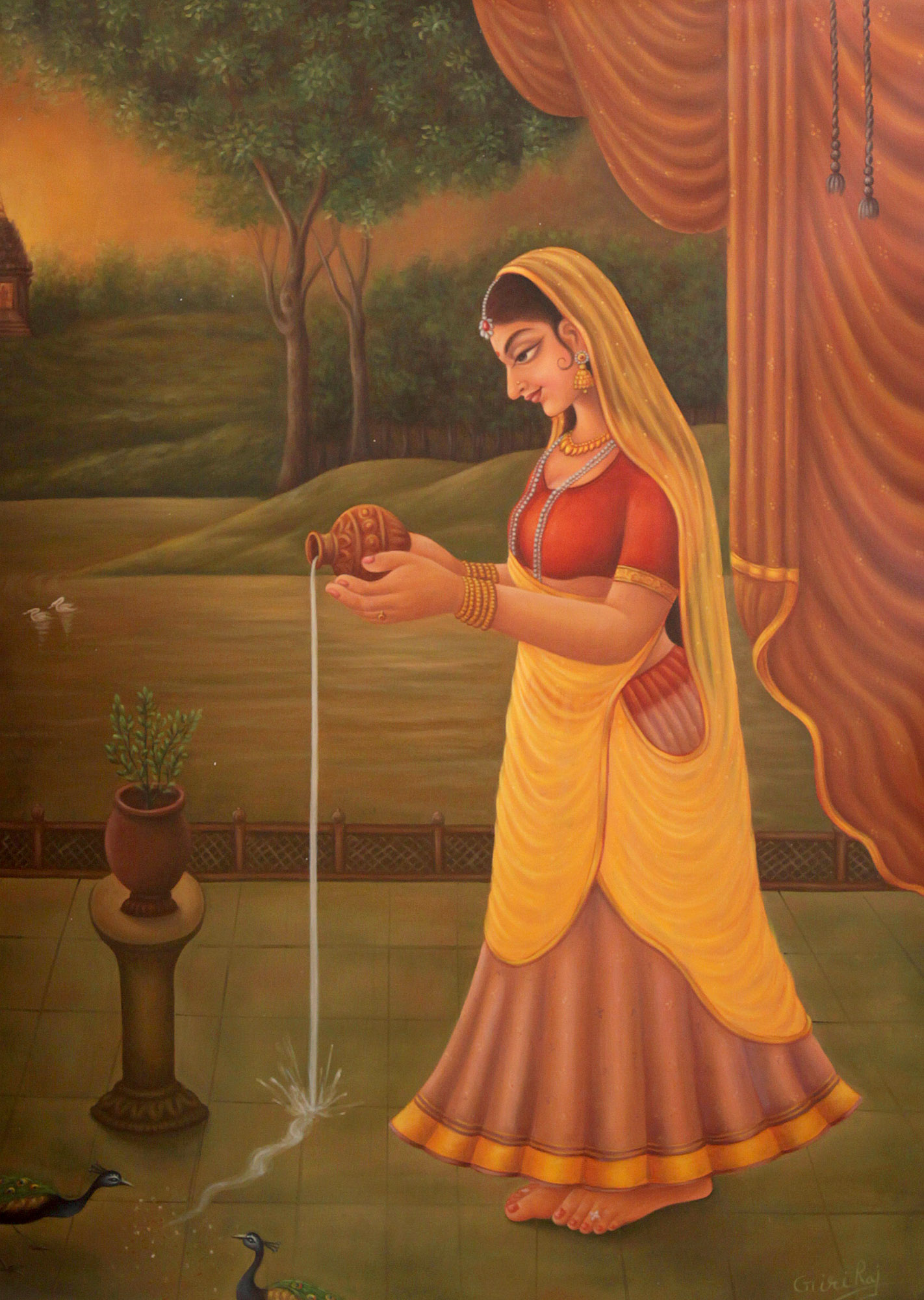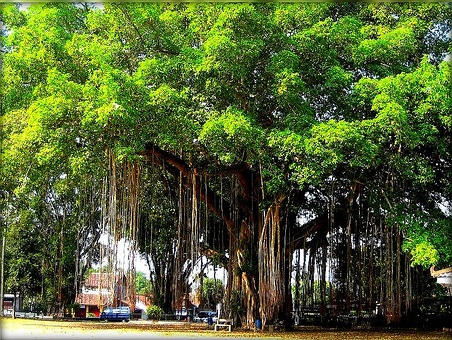Many Vedic Traditions were considered superstitions, but upon introspection it is
becoming evident that these traditions are based on full-proof scientific knowledge. They have moved from generations to generations as traditions and often the common
people were unaware of the science behind them. Lets make an attempt to bring forward the science involved in each of these traditions and rituals.
 1. Why do we worship Tulsi Plant:
1. Why do we worship Tulsi Plant: Hindu religion has bestowed ‘Tulsi’, with the status of mother. Also known as ‘Sacred or Holy Basil’, Tulsi, has been recognized as a religious and spiritual devout in many parts of the world. The vedic sages knew the benefits of Tulsi and that is why they personified it as a Goddess and gave a clear message to the entire community that it needs to be taken care of by the people, literate or illiterate. We try to protect it because it is like Sanjeevani for the mankind. Tulsi has great medicinal properties. It is a remarkable antibiotic. Taking Tulsi everyday in tea or otherwise increases immunity and help the drinker prevent diseases, stabilize his or her health condition, balance his or her body system and most important of all, prolong his or her life. Keeping Tulsi plant at home prevents insects and mosquitoes from entering the house. It is said that snakes do not dare to go near a Tulsi plant. Maybe that is why ancient people would grow lots of Tulsi near their houses.
2. Joining Both Palms together to Greet:
In Hindu culture, people greet each other by joining their
palms – termed as “Namaskar.” The general reason behind this tradition is that
greeting by joining both the palms means respect. However, scientifically
speaking, joining both hands ensures joining the tips of all the fingers
together; which are denoted to the pressure points of eyes, ears, and mind.
Pressing them together is said to activate the pressure points which helps us
remember that person for a long time. And, no germs since we don’t make any
physical contact!
3. Why do Indian Women wear Toe Ring:

Wearing toe rings is not just the significance of married
women but there is science behind it. Normally toe rings are worn on the second
toe. A particular nerve from the second toe connects the uterus and passes to
heart. Wearing toe ring on this finger strengthens the uterus. It will keep it
healthy by regulating the blood flow to it and menstrual cycle will be
regularized. As Silver is a good conductor, it also absorbs polar energies from
the earth and passes it to the body.
4. Applying Tilak on the Forehead:
On the forehead, between the two eyebrows, is a spot that is
considered as a major nerve point in human body since ancient times. The Tilak
is believed to prevent the loss of “energy”, the red ‘kumkum’ between the
eyebrows is said to retain energy in the human body and control the various
levels of concentration. While applying kumkum the points on the mid-brow
region and Adnya-chakra are automatically pressed. This also facilitates the blood
supply to the face muscles.
5. Why do Temples have Bells:

People who are visiting the temple should and will Ring the
bell before entering the inner sanctum (Garbhagudi or Garbha Gruha or
womb-chamber) where the main idol is placed. According to Agama Sastra, the
bell is used to give sound for keeping evil forces away and the ring of the
bell is pleasant to God. However, the scientific reason behind bells is that
their ring clears our mind and helps us stay sharp and keep our full
concentration on devotional purpose. These bells are made in such a way that
when they produce a sound it creates a unity in the Left and Right parts of our
brains. The moment we ring the bell, it produces a sharp and enduring sound
which lasts for minimum of 7 seconds in echo mode. The duration of echo is good
enough to activate all the seven healing centres in our body. This results in
emptying our brain from all negative thoughts.
6. Why do we have Navratras: Our living style
has drastically changed if we compare it to the society hundreds &
thousands of years ago. The traditions which we follow in present are not
establishments of today but of the past. Ever thought, why do we have Navratras
twice a year unlike other festivals like Deepawali or Holi? Well, both these
months are the months of changing seasons and the eating habits of both the
seasons are quite different from each other. Navratras give enough time to the
body to adjust and prepare itself for to the changing season. These nine days
were marked as a period when people would clean their body system by keeping
fasts by avoiding excessive salt and sugar, meditate, gain a lot of positive
energy, gain a lot of self confidence & increase the self determination
power (fasts are a medium to improve our will power and self determination) and
finally get ready for the challenges of the changed season.
7. The scientific explanation of touching Feet:
Usually, the person of whose feet you are touching is either old or pious. When they accept your respect which came from your reduced ego (and is called your shraddha) their hearts emit positive thoughts and energy (which is called their karuna) which reaches you through their hands and toes. In essence, the completed circuit enables flow of energy and increases cosmic energy, switching on a quick connect between two minds and hearts. To an extent, the same is achieved through handshakes and hugs. The nerves that start from our brain spread across all your body. These nerves or wires end in the fingertips of your hand and feet. When you join the fingertips of your hand to those of their opposite feet, a circuit is immediately formed and the energies of two bodies are connected. Your fingers and palms become the ‘receptor’ of energy and the feet of other person become the ‘giver’ of energy.
8. Why do we worship Peepal Tree:

‘Peepal’ tree is almost useless for an ordinary person,
except for its shadow. ‘Peepal’ does not a have a delicious fruit, its wood is
not strong enough for any purpose then why should a common villager or person
worship it or even care for it? Our ancestors knew that ‘Peepal’ is one of the
very few trees (or probably the only tree) which produces oxygen even at night.
So in order to save this tree because of its unique property they related it to
God/religion.
9. Start with Spice & End with Sweet:
Our ancestors have stressed on the fact that our meals
should be started off with something spicy and sweet dishes should be taken
towards the end. The significance of this eating practice is that while spicy
things activate the digestive juices and acids and ensure that the digestion
process goes on smoothly and efficiently, sweets or carbohydrates pulls down
the digestive process. Hence, sweets were always recommended to be taken as a
last item.
10. Choti on the Male Head:
Sushrut rishi, the foremost surgeon of Ayurveda, describes
the master sensitive spot on the head as Adhipati Marma, where there is a nexus
of all nerves. The shikha protects this spot. Below, in the brain, occurs the
Brahmarandhra, where the sushumnã (nerve) arrives from the lower part of the
body. In Yog, Brahmarandhra is the highest, seventh chakra, with the thousand-petalled
lotus. It is the centre of wisdom. The knotted shikhã helps boost this centre
and conserve its subtle energy known as ojas.
 11. Applying Mehendi/Henna on the Hand:
11. Applying Mehendi/Henna on the Hand:
Besides lending color to the hands, mehndi is a very
powerful medicinal herb. Weddings are stressful, and often, the stress causes
headaches and fevers. As the wedding day approaches, the excitement mixed with
nervous anticipation can take its toll on the bride and groom. Application of
mehndi can prevent too much stress because it cools the body and keeps the
nerves from becoming tense. This is the reason why mehndi is applied on the
hands and feet, which house nerve endings in the body.
12. Celebration & Cleaning During Diwali:
Diwali usually falls in October or November which marks the
start of winter season and end of rainy season. Rainy season wasn’t a good time
for everyone back then; many homes needed repair and renovation after a heavy
fall. That is why time before diwali was considered the period during which
everyone can indulge in cleaning and beautification of their home. And also
take out their winter clothes and pack the summer ones.
13. Sitting on the Floor & Eating:
This tradition is not just about sitting on floor and
eating, it is regarding sitting in the “Sukhasan” position and then eating.
Sukhasan is the position we normally use for Yoga asanas. Sitting in this
position while eating helps in improving digestion as the circulatory system
can focus solely upon digestion and not on our legs dangling from a chair or
supporting us while we are standing.
13. Why not to sleep with Your Head towards North:
Myth is that it invites ghost or death but science says that
it is because human body has its own magnetic field (Also known as hearts
magnetic field, because the flow of blood) and Earth is a giant magnet. When we
sleep with head towards north, our body’s magnetic field become completely
asymmetrical to the Earth’s Magnetic field. That cause problems related to
blood pressure and our heart needs to work harder in order to overcome this
asymmetry of Magnetic fields. Apart from this another reason is that Our body
have significant amount of iron in our blood. When we sleep in this position,
iron from the whole body starts to congregate in brain. This can cause
headache, Alzheimer’s Disease, Cognitive Decline, Parkinson disease and brain
degeneration.
14. Surya Namaskar:
Hindus have a tradition of paying regards to Sun God early
in the morning by their water offering ritual. It was mainly because looking at
Sun rays through water or directly at that time of the day is good for eyes and
also by waking up to follow this routine, we become prone to a morning
lifestyle and mornings are proven to be the most effective part of the day.
15. Ear Piercing:
Piercing the ears has a great importance in Indian ethos.
Indian physicians and philosophers believe that piercing the ears helps in the
development of intellect, power of thinking and decision making faculties.
Talkativeness fritters away life energy. Ear piercing helps in
speech-restraint. It helps to reduce impertinent behaviour and the ear-channels
become free from disorders. This idea appeals to the Western world as well, and
so they are getting their ears pierced to wear fancy earrings as a mark of
fashion.
16. Application of Sindoor or Vermillion:

It is interesting to note that that the application of
sindoor by married women carries a physiological significance. This is so
because Sindoor is prepared by mixing turmeric-lime and the metal mercury. Due
to its intrinsic properties, mercury, besides controlling blood pressure also
activates sexual drive. This also explains why Sindoor is prohibited for the
widows. For best results, Sindoor should be applied right upto the pituitary
gland where all our feelings are centered. Mercury is also known for removing
stress and strain.
17. Throwing Coins into a River:
The general reasoning given for this act is that it brings Good Luck. However, scientifically speaking, in the ancient times, most of the currency used was made of copper unlike the stainless steel coins of today. Copper is a vital metal very useful to the human body. Throwing coins in the river was one way our fore-fathers ensured we intake sufficient copper as part of the water as rivers were the only source of drinking water. Making it a custom ensured that all of us follow the practice.
18. Why do we Fast:
The underlying principle behind fasting is to be found in
Ayurveda. This ancient Indian medical system sees the basic cause of many
diseases as the accumulation of toxic materials in the digestive system.
Regular cleansing of toxic materials keeps one healthy. By fasting, the
digestive organs get rest and all body mechanisms are cleansed and corrected. A
complete fast is good for heath, and the occasional intake of warm lemon juice
during the period of fasting prevents the flatulence. Since the human body, as
explained by Ayurveda, is composed of 80% liquid and 20% solid, like the earth,
the gravitational force of the moon affects the fluid contents of the body. It
causes emotional imbalances in the body, making some people tense, irritable
and violent. Fasting acts as antidote, for it lowers the acid content in the
body which helps people to retain their sanity. Research suggests there are
major health benefits to caloric restriction like reduced risks of cancer,
cardiovascular diseases, diabetes, immune disorders etc.
19. Why do Indian Women wear Bangles:

Normally the wrist portion is in constant activation on any human. Also the pulse beat in this portion is mostly checked for all sorts of ailments. The Bangles used by women are normally in the wrist part of ones hand and its constant friction increases the blood circulation level. Further more the electricity passing out through outer skin is again reverted to one’s own body because of the ring shaped bangles, which has no ends to pass the energy outside but to send it back to the body.
20. Why Idol Worship:
Hinduism propagates idol worship more than any other
religion. Researchers say that this was initiated for the purpose of increasing
concentration during prayers. According to psychiatrists, a man will shape his
thoughts as per what he sees. If you have 3 different objects in front of you,
your thinking will change according to the object you are viewing. Similarly,
in ancient India, idol worship was established so that when people view idols
it is easy for them to concentrate to gain spiritual energy and meditate
without mental diversion.
Source: Internet



















